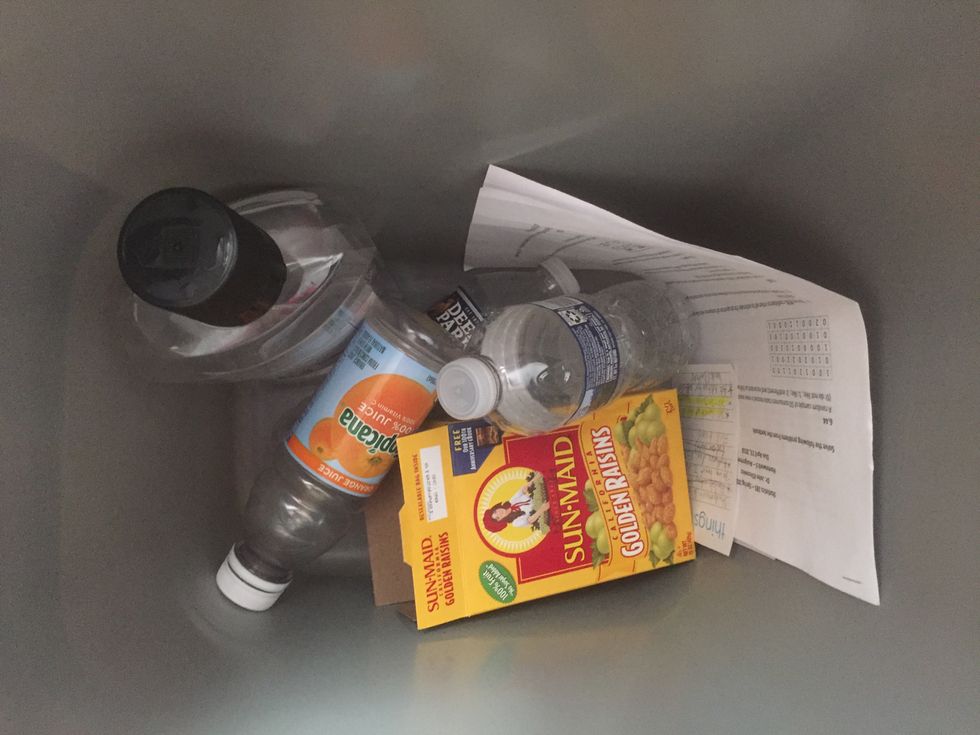Non-recyclable items that end up in the recycling bin is considered contamination. It raises the cost and time of sorting and processing, lowers the marketability of the materials being recycled, and, in some cases, causes otherwise good recyclables to go to the landfill.
Contamination in recycling bins is a huge problem throughout the United States and around the world. In some places, recycling bins have been removed since contamination is so high- this is especially true with bins in parks and other outdoor spaces. Many recycling providers are charging fees because they must slow down the separation process to remove non-recyclable items and sell some materials at a lower price due to its lower quality.
Over the last year, China placed import bans on bales of recyclables that have higher than a 0.5% contamination rate. The issue is that people are sometimes confused about what they can recycle at the curb or in a public space, which can lead to unaccepted items ending up in the recycling container. Here are some general guidelines to follow to help ensure that what you are placing in the bin will be recycled. (Note: These guidelines are primarily for single-stream recycling programs, but will generally apply to any recycling program.)
Please check with your waste hauler for specific guidelines. If you live on campus at college, check with your facilities department for information on recycling, electronics, and hazardous waste disposal.
In most places, only news/copy/notebook paper, boxes (without packaging), empty (plastic or glass) bottles, jugs and jars, and empty (steel and aluminum) cans are recyclable in residential and single-stream recycling containers.
1. No flexible plastics
In almost every case the numbers that your recycling hauler takes only applies to rigid plastics. Flexible plastics have different melting points, light and jam up separation machines at the materials recovery facility (or recycling plant). Grocery bags, air cushions, and film over-wraps may have a 2 or 4 recycling symbol, but they can only be recycled via drop-off locations (See: https://www.plasticfilmrecycling.org)
2. Don't bag recyclables
As mentioned above flexible plastics like bags can't be recycled. Bagging recyclables often increase the likelihood of them ending up in a landfill since it is very tedious and time consuming for workers to open bags. Most companies require curbside recyclables to be placed in the bin loose and require any recyclables placed in black trash bags to be thrown out for safety reasons. If you need to use a bag to collect your recyclables, dump the contents into your bin and reuse the bag. If your city or waste hauler requires recyclables to be bagged, then they need to be in a clear one.
Businesses, schools, and public facilities are allowed to place recyclables in clear plastic bags for sanitation and collection reasons.
3. Paper or cardboard that touches food or liquids is trash
Paper cups, plates, towels, and napkins are not recyclable because food, grease, and other residues simply can't be removed from fiber or wood-based products. In paper towels and napkins, the fiber length is too short to be recover again. While theoretically paper plates can be recycled if they are clean, but when was the last time you had a spotless plate after eating? In the case of pizza boxes, the bottom is usually greasy, but the top is often clean, so you can rip off the top and toss the base in the trash. A good rule to flow is that any paper you read or write on is recyclable.
4. Empty containers of food, liquids & sauce
All containers need to be empty before recycling. Food contaminates other items and causes materials to go to the landfill. Drinks destroy the quality of paper and cardboard (sending them to the trash) and create a mess at the plant. Some containers, like yogurt tubs, aluminum trays, and sauce jars, may need to be rinsed or scraped to remove most of the residue. Leftover food and drinks can create a foul odor in your recycling bin. Containers don't need to be spotless but try to get most of the gunk out.
5. No multi-composition items
Items like pumps, triggers, shoes, toys, shipping envelopes, frozen food bags, housewares, waxed paper cups, and wrappers have more than one type of material fused, which makes them too intricate to recycle cost-effectively. Electronics, printer cartridges, and appliances, however, can and should be recycled (through drives, mail-in or drop-off locations only, check with the manufacturer or your county) since they contain precious metals and have high reusability.
6. No 2D plastics (i.e. loose lids, disks, CDs, flat sheets)
Materials are sorted by shape to separate paper and cardboard from containers. Flat pieces of plastic can mix in with the paper and can sometimes bypass quality control, causing contamination of bales of paper/cardboard.
7. Nothing long and stringy (i.e. rope, cords, ribbons, and hoses)
Items that are long and stringy(i.e. rope, cords, and hoses) will wrap around any rotating machinery, used to separate materials by size and shape, and cause them to stop working.
8. No foam products or hazardous materials
Foam is more than 95% air and therefore, cannot be economically recycled.
Sharp objects and products containing hazardous chemicals are harmful to workers and can sometimes cause fires at recycling facilities. Hazardous chemical containers (like propane tanks, pesticide, paint, antifreeze, and motor oil containers) cannot be recycled for safety reasons. If a bottle containing hazardous chemicals is not empty, then it should be taken to a hazardous waste collection event or drop-off site, check with your county. Propane tanks, dead fluorescent light bulbs and rechargeable batteries must also be to a hazardous waste collection event or drop-off site. Single-use (Alkaline) batteries can go in the trash.

















